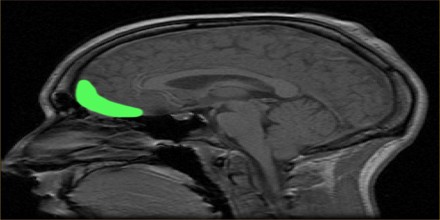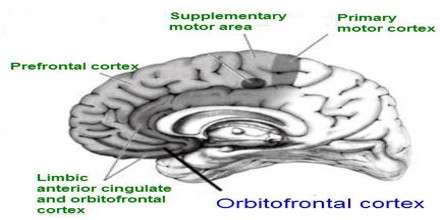Orbitofrontal Cortex
Definition
Orbitofrontal Cortex (OFC) is a structure in which multiple sensory information and reward information converge. It is a prefrontal cortex region in the frontal lobes in the brain which is involved in the cognitive processing of decision-making. In non-human primates it consists of the association cortex areas Brodmann area 11, 12 and 13; in humans it consists of Brodmann area 10, 11 and 47.

It also receives visual, somatosensory, and auditory inputs through the uncinate fascicles and/or through the subcortical structures. The OFC is also densely connected with limbic/paralimbic structures. It is defined as the part of the prefrontal cortex that receives projections from the magnocellular, medial nucleus of the mediodorsal thalamus, and is thought to represent emotion and reward in decision making. It gets its name from its position immediately above the orbits in which the eyes are located.
Structure and Functions of Orbitofrontal Cortex (OFC)
Orbitofrontal Cortex (OFC) has been divided by structure and connections into a medial and a lateral part. The medial part is most strongly connected with the hippocampus and associated areas of the cingulate, retrosplenial and entorhinal cortices, anterior thalamus and septal diagonal band. The lateral part can be further subdivided into three sectors.
It also contains the secondary and tertiary olfactory cortical areas, in which information about the identity and also about the reward value of odours is represented. The orbitofrontal cortex also receives information about the sight of objects from the temporal lobe cortical visual areas, and neurons in it learn and reverse the visual stimulus to which they respond when the association of the visual stimulus with a primary reinforcing stimulus is reversed.

The orbitofrontal cortex (OFC) has been implicated in the pathophysiology of major depression by evidence obtained using neuroimaging, neuropathologic, and lesion analysis techniques. The abnormalities revealed by these techniques show a regional specificity, and suggest that some OFC regions which appear cytoarchitectonically distinct also are functionally distinct with respect to mood regulation. Functionally distinct pathways for auditory processing in the orbitofrontal cortex include a rostral stream associated with phonetic processing, and a more caudal stream terminating just posterior to the orbitofrontal cortex in the periarcuate prefrontal cortex associated with auditory-spatial processing, though these connections share extensive overlap. Both ventral and dorsal visual streams share connections with orbitofrontal cortical areas, including rich projections to and from the superior temporal pole, important for integration of spatial and object processing.
The human OFC is among the least-understood regions of the human brain; but it has been proposed that the OFC is involved in sensory integration, in representing the affective value of reinforcers, and in decision-making and expectation.
















